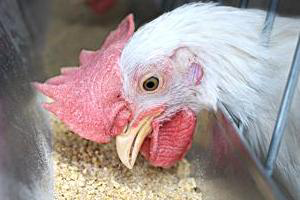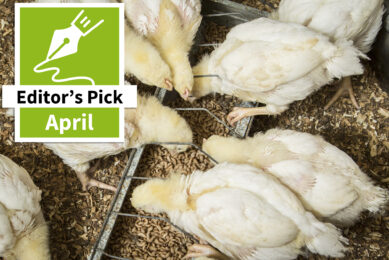Poultry sector consumes the most feed

Poultry held its position as the leading consumer of animal feed, with a 46% share of ?global production at 444 million tonnes, ?representing a 6% growth over 2012. This is stated in the 2014 Global Feed Tonnage Survey, recently released by Alltech.
By Emmy Koeleman
For 2013, Alltech assessed the compound feed production of 130 countries through information obtained in partnership with local feed associations and Alltech’s sales team, who visit more than 28,000 feed mills annually. The findings from 2013 reveal a one percent increase in the feed industry with a global feed tonnage of 963 million metric tonnes, up from 954 million metric tonnes last year (plus one percent). This modest increase was likely influenced by droughts in more than 30 countries worldwide in 2012, which, in turn, drove up the price of raw feed materials. The highest average cost of feed was experienced in Asia, averaging around $524 (€387) per ton for pig finisher diets and around $480-$550 (€355-407 ) for chicken finisher diets. However, the final months of 2013 saw a significant drop in feed prices in Asia, a trend which could continue into 2014 and result in a year of recovery and perhaps even growth ahead. “We were surprised that the feed industry did not break the one billion metric ton level in 2013, given the continued global growth in the consumption of animal proteins. But this is mainly due to the a series of droughts that has plagued many countries in 2012 and therefore influenced the prices and growth in 2013. With a significant drop in cereal prices during the final months of 2013, our respondents expect the feed prices will be lower in 2014, resulting in a year of recovery and a return to stronger growth in terms of tons of feed produced”, said Aidan Connolly, vice president of Alltech and director of Alltech’s annual Global Feed Tonnage Survey.
China number one but less mills
Asia, of the six regions surveyed, is once again the leading overall region in terms of production of animal feed, with 348 million metric tonnes or more than one-third of global feed, but did not grow in 2013. The Middle East is estimated to have the largest feed mills by average tons per year. Globally, feed mills produced an average of 34,000 metric tonnes. Among the 130 countries assessed, China was once again the number one country
producing feed at 189 million metric tonnes and an estimated 9,500 feed mills. The US and Brazil ranked second and third respectively, with the US producing 169 million metric tonnes from 5,236 feed mills and Brazil generating 67 million metric tonnes from 1,237 feed mills. From the European countries, Spain was the biggest producer in 2013 with a total of 28.9 million tonnes of feed produced. The Netherlands ranked 17th with a total of 13 million tonnes produced. Regarding the number of feed mills, Alltech estimated 28,200 mills globally. Asia has the most feed mills (13,266), but there was an observed decline in the number of feed mills in China, likely driven by government policy, which favours a smaller number of larger feed mills to facilitate traceability and improvements in quality, and the continued demand by urban consumers for further processed proteins from larger farms. In 2013, the number of feed mills in North America was 5,736, in Europe 4,886, in Latin America 3,126, in Africa 806 and 380 in the Middle East.
Africa is growing fast, Asia biggest region
In terms of percent growth in comparison to the December 2012 figures, Africa was reaffirmed as the fastest growing region. Countries such as South Africa, Ivory Coast, Senegal, Mauritius and Namibia all experienced production increases, boosting Africa’s combined tonnage 7% to just short of 31 million metric tonnes in 2013.
Most feed to poultry, rise in aquafeed
Poultry held its position as the leading consumer of animal feed, with a 46.1% share ( Figure 1) of global production at 444 million tonnes, representing a 6% growth over 2012. 60% of all poultry feed tonnage is dedicated to broilers, with the rest fed to egg layers, turkeys, duck and other fowl. Pig feed increased by 11%, moving to 243 million metric tonnes globally. Pig feed takes up 25.2% of the total feed volume. The ruminant feed market, comprising dairy, beef and small ruminants, decreased in tonnage demand between late 2012 and December 2013 and take up 20.35%. These animal sectors have the most alternative feed materials to switch to, including grazing and forages, when grain prices rise. Equine feed tonnage once again increased 14% to 12.4 million metric tonnes, following on a 17% increase in 2012. Aquaculture was the star performer again, with a 17% increase in 2013 to 34.4 million metric tonnes. In terms of volume, it still ‘only’ takes up 4.15% of the total volume of feed
produced on the world market. The Food and Agriculture Organization of the United Nations (FAO) trends suggest that global consumption total of farmed fish and shellfish now exceeds beef on weight basis. Pet food tonnage remained relatively flat from 2012 to 2013, increasing just slightly from 20.5 to 20.7 million tonnes.
Higher total value
The survey found that the total value of the feed industry exceeds $500 billion (€ 360 billion), higher than the previous estimate of $350 billion (€259 billion). This has been fuelled by high feed prices but also by the more accurate information collected by this survey. With an expected fall in feed prices in 2014, this value of the feed industry will likely not be as high in 2014. “This investment in evaluating the world’s feed industry is a part of our ongoing commitment from seed to feed to food in order to satisfy a growing population worldwide,” said Dr. Pearse Lyons, president of Alltech. “With Africa once again named the fastest growing region, we need to be asking ourselves, ‘What if sustainable aquaculture could eradicate poverty and hunger in Africa? What if farm yields in Africa were increased by 20% ?”.
Article featured in AllAboutFeed 22.2
Join 26,000+ subscribers
Subscribe to our newsletter to stay updated about all the need-to-know content in the feed sector, three times a week. Beheer
Beheer









 WP Admin
WP Admin  Bewerk bericht
Bewerk bericht